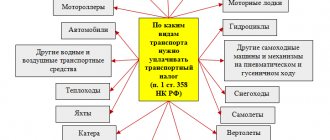The collection of taxes from vehicle owners is provided for by the legislation of most states. In the Russian Federation, the need for its payment by citizens and legal entities is enshrined in Chapter 28 of the Tax Code. Based on its provisions, transport tax in our country is regional. Accordingly, each subject of the Federation sets the collection procedure, current rates and payment terms independently, in accordance with its legal regulations.
When to pay
According to clause 1 of Article 363 of the Tax Code of the Russian Federation, tax is payable:
- taxpayers - individuals no later than December 1 of the year following the expired tax period;
- taxpayers - organizations within the time limits established by the laws of the constituent entities of the Russian Federation.
From 01/01/2021, a new version of this article will be in effect, according to which the tax will be payable by taxpayer organizations no later than March 1 of the year following the expired tax period. Advance tax payments will be subject to payment by taxpayer organizations no later than the last day of the month following the expired reporting period.
Who needs to pay transport tax
It is a common belief that only owners of trucks and cars pay the tax. However, it is not. The owners of any vehicles registered with the registration authorities have to pay a contribution to the regional treasury. The list includes airplanes, steamships, yachts, motor sleighs and much more.
Art. 358 of the Tax Code of the Russian Federation indicates exemption from tax payments to owners of the following vehicles:
- passenger vehicles equipped for driving by disabled people, if the installed engine has a power of less than 100 hp, and the receipt was made through social security authorities in accordance with the law;
- tractors, combines and special equipment registered to agricultural producing enterprises;
- boats without engines, as well as with engines, provided their power is less than 5 hp;
- aircraft registered for air ambulance and medical services;
- for transport of executive authorities, provided that service in their ranks is equivalent to military service or is such;
- sea, river and aircraft, if for their owners the main activity of transporting passengers or delivering goods;
- drilling ships and platforms;
- fishing and river vessels, as well as vessels registered in the Russian International Register of Vessels.
Transport tax is not withheld from stolen vehicles, even if the search for them has been stopped.
Transport tax rate for cars in Moscow for 2020
| Name of taxable object | Rate (RUB) |
| Passenger cars with engine power (transport tax is calculated for each horsepower of the vehicle): | |
| up to 100 l. With. (up to 73.55 kW) inclusive | 12 |
| over 100 hp up to 125 hp (over 73.55 kW to 91.94 kW) inclusive | 25 |
| over 125 hp up to 150 hp (over 91.94 kW to 110.33 kW) inclusive | 35 |
| over 150 hp up to 175 hp (over 110.33 kW to 128.7 kW) inclusive | 45 |
| over 175 hp up to 200 hp (over 128.7 kW to 147.1 kW) inclusive | 50 |
| over 200 hp up to 225 hp (over 147.1 kW to 165.5 kW) inclusive | 65 |
| over 225 hp up to 250 hp (over 165.5 kW to 183.9 kW) inclusive | 75 |
| over 250 hp (over 183.9 kW) | 150 |
| Motorcycles and scooters with engine power (transport tax is calculated for each horsepower): | |
| up to 20 l. With. (up to 14.7 kW) inclusive | 7 |
| over 20 l. With. up to 35 l. With. (over 14.7 kW to 25.74 kW) inclusive | 15 |
| over 35 l. With. (over 25.74 kW) | 50 |
| Buses with engine power (per horsepower): | |
| up to 110 hp (up to 80.9 kW) inclusive | 15 |
| over 110 hp up to 200 hp (over 80.9 kW to 147.1 kW) inclusive | 26 |
| over 200 l. With. (over 147.1 kW) | 55 |
| Trucks with engine power (per horsepower): | |
| up to 100 l. With. (up to 73.55 kW) inclusive | 15 |
| over 100 l. With. up to 150 l. With. (over 73.55 kW to 110.33 kW) inclusive | 26 |
| over 150 l. With. up to 200 l. With. (over 110.33 kW to 147.1 kW) inclusive | 38 |
| over 200 l. With. up to 250 l. With. (over 147.1 kW to 183.9 kW) inclusive | 55 |
| over 250 l. With. (over 183.9 kW) | 70 |
| Other self-propelled vehicles, pneumatic and tracked machines and mechanisms (per horsepower) | 25 |
| Snowmobiles, motor sleighs with engine power (per horsepower): | |
| up to 50 l. With. (up to 36.77 kW) inclusive | 25 |
| over 50 l. With. (over 36.77 kW) | 50 |
| Boats, motor boats and other water vehicles with engine power (per horsepower): | |
| up to 100 l. With. (up to 73.55 kW) inclusive | 100 |
| over 100 l. With. (over 73.55 kW) | 200 |
| Yachts and other sailing-motor vessels with engine power (per horsepower): | |
| up to 100 l. With. (up to 73.55 kW) inclusive | 200 |
| over 100 l. With. (over 73.55 kW) | 400 |
| Jet skis with engine power (per horsepower): | |
| up to 100 l. With. (up to 73.55 kW) inclusive | 250 |
| over 100 l. With. (over 73.55 kW) | 500 |
| Non-self-propelled (towed) vessels for which gross tonnage is determined (transport tax is calculated for each registered ton of gross tonnage) | 200 |
| Airplanes, helicopters and other aircraft with engines (per horsepower) | 250 |
| Airplanes with jet engines (per kilogram of thrust) | 200 |
| Other water and air vehicles without engines (per vehicle unit) | 2000 |
Transport tax by region
- 01Adygea rep.
- 02Bashkortostan rep.
- 03Buryatia rep.
- 04Altai rep.
- 05Dagestan rep.
- 06Ingushetia rep.
- 07Kabardino-Balkarian Republic
- 08Kalmykia rep.
- 09Karachay-Cherkess Republic
- 10Karelia rep.
- 11Komi rep.
- 12Mari El rep.
- 13Mordovia rep.
- 14Sakha (Yakutia) rep.
- 15North Ossetia rep.
- 16Tatarstan rep.
- 17Tuva rep.
- 18Udmurt Republic
- 19Khakassia rep.
- 21 Chuvash Republic
- 22Altai region
- 23Krasnodar region
- 24Krasnoyarsk region
- 25Primorsky Krai
- 26Stavropol region
- 27Khabarovsk region
- 28Amur region
- 29Arkhangelsk region
- 30Astrakhan region
- 31Belgorod region
- 32Bryansk region
- 33Vladimir region
- 34Volgograd region
- 35Vologda region
- 36Voronezh region
- 37Ivanovo region
- 38Irkutsk region
- 39Kaliningrad region
- 40Kaluga region
- 41Kamchatka region
- 42Kemerovo region
- 43Kirov region
- 44Kostroma region
- 45Kurgan region
- 46Kursk region
- 47Leningrad region
- 48Lipetsk region
- 49Magadan region
- 50Moscow region
- 51Murmansk region
- 52Nizhny Novgorod region
- 53Novgorod region
- 54Novosibirsk region
- 55 Omsk region
- 56 Orenburg region
- 57 Oryol region
- 58Penza region
- 59Perm region
- 60Pskov region
- 61Rostov region
- 62Ryazan region
- 63Samara region
- 64Saratov region
- 65Sakhalin region
- 66Sverdlovsk region
- 67Smolensk region
- 68Tambov region
- 69Tver region
- 70Tomsk region
- 71Tula region
- 72 Tyumen region
- 73Ulyanovsk region
- 74 Chelyabinsk region
- 75Transbaikal region
- 76Yaroslavl region
- 77Moscow
- 78St. Petersburg
- 79Jewish Autonomous Region
- 82 Crimea rep.
- 83Nenets Autonomous District
- 86Khanty-Mansi Autonomous Okrug - Yugra
- 87Chukotka Autonomous Okrug
- 89Yamalo-Nenets Autonomous Okrug
- 92Sevastopol
- 95Chechen Republic
See also: - Transport tax for a motorcycle, scooter - Transport tax for a truck - Transport tax for a bus - Transport tax for a boat, yacht, jet ski - Transport tax for an aircraft - Transport tax for pensioners - Transport tax for luxury cars
How is transport tax calculated?
Individuals do not have to worry about the amount of tax they will have to pay. The tax service makes the calculations independently. The taxpayer receives a notification of the need to pay on time in the form of a registered letter or notification on the State Services, as well as in the taxpayer’s personal account.
However, this does not mean that the tax amount is some kind of secret. If a citizen buys a car and wants to find out how much he will have to pay for it annually, you can use the calculator on the website of the Federal Tax Service. Those who do not trust government officials can make the calculations themselves
The vehicle tax formula generally looks like this:
Amount of transport tax = Regional rate * Engine power (hp)
And more precisely like this:
Amount of transport tax = Regional rate * Engine power (hp) * Period of use (months) * Increasing or decreasing factor
Those. If the vehicle ownership period is less than one year, another multiplier is added to the formula. It is equal to the number of months of ownership divided by 12.
The formula may also contain increasing and decreasing coefficients. For example, such a coefficient is provided for citizens who own cars worth more than 3 million rubles. All information on bets and odds is posted on the Federal Tax Service website.
Transport tax - what is it?
Transport tax is a generally obligatory amount that owners of vehicles (vehicles) must pay in accordance with the procedure established by law.
Transport tax is a regional tax. This means that the money goes to the regional budget, and the specific amount of the tax and its other features are reflected in the laws of the regions of the Russian Federation. The tax is paid for each vehicle owned by the owner. It must be paid once a year. General information about the transport tax is contained in Chapter 28 of the Tax Code of the Russian Federation (TC RF).
What do we pay for?
The objects of transport tax are defined in Article 358 of the Tax Code of the Russian Federation. They are vehicles that are registered and registered in accordance with the requirements of the law, namely:
- mechanical vehicles (cars, motorcycles, buses, etc.);
- helicopters, airplanes;
- water vehicles (yachts, motor boats, speedboats, jet skis, etc.);
- motor sleighs, snowmobiles.
The same article of the Tax Code of the Russian Federation contains a detailed list of vehicles that are not subject to taxation. These include vehicles of low power or those necessary to perform socially significant tasks, for example:
- air, river, sea vessels for cargo or passenger transportation;
- medical aircraft;
- rowing boats and motorboats with a maximum power of 5 horsepower, fishing vessels;
- sea and river vessels, information about which is included in the Russian International Register of Ships;
- Vehicles used in agriculture;
- a car designed to transport disabled people;
- Vehicles owned by the state. bodies through which military service is carried out.
Agricultural machinery is not subject to transport tax
Stolen vehicles that have not yet been found at the time of tax payment are not subject to tax. In order not to pay tax on a stolen car you must:
- Contact the police to report the car theft. This will begin the investigation and search for the vehicle. Important: only those vehicles that are wanted are exempt from tax.
- Obtain a certificate from the police about the theft of a car.
- Write an application for tax exemption and send it along with a certificate of theft to the Federal Tax Service of the Russian Federation (FTS). This can be done by contacting the Federal Tax Service in person or in your personal account on the official website of this state. organ. You must bring the original or a copy of the certificate.
- Wait for notification from the Federal Tax Service about the results of consideration of the application. If the decision is positive, you will be exempt from transport tax.
An application for tax exemption and a certificate must be submitted every year. If for some reason it seems to you that searching for a car is a hopeless matter, then you can contact the traffic police and deregister the vehicle by writing an application to terminate the registration of the car.
Who pays
Transport tax payers are persons who own vehicles specified in paragraph 1 of Art. 358 Tax Code of the Russian Federation. That is, it is paid by individuals and organizations to which the vehicle is registered. Information about the owners is sent to the Federal Tax Service by the State Traffic Safety Inspectorate.
Privileges
Transport tax benefits can be federal and regional.
Federal benefits regarding vehicle tax are specified in the Tax Code. For example, special privileges are provided to individual owners of heavy vehicles included in the Register of Vehicles of the toll collection system.
The essence of the last benefit is that heavy trucks cause damage to the road surface. Therefore, truck owners were obliged to pay compensation to the Russian budget (the funds received go to road repairs), but at the same time they provided benefits in two forms:
- full exemption from vehicle tax is given if the compensation paid is greater than or equal to the vehicle tax;
- A “discount” on tax is given if the compensation paid is less than the amount of tax (calculated tax - payment amount = actual tax paid).
Payers of the Platon system reduce transport tax by the amount of this fee
The rules on regional benefits are contained in the laws of the constituent entities of the Russian Federation. Regional transport tax benefits may be provided to:
- veterans;
- disabled people;
- large families;
- owners of small vehicles;
- other categories of citizens.
It must be borne in mind that local benefits are individual for each region, and therefore they need to be clarified at the branches of the Federal Tax Service. Detailed information about tax benefits for a specific region can be obtained in the “Reference Information” section of the Federal Tax Service website.
To receive any benefit, you must contact the Federal Tax Service along with an application and documents for the benefit.
Video: owners of electric vehicles were offered exemption from transport tax
What does the tax depend on?
The amount of any tax, including transport tax, consists of the tax base and tax rate.
The tax base is a characteristic of the object of taxation that is important for calculating tax. Its main task is to “measure” the object of taxation. The tax base for transport tax is:
- engine power in horsepower (vehicles with engines);
- jet engine thrust (aircraft for which this characteristic can be determined);
- vehicle unit (other aircraft, watercraft).
The tax rate is the amount of payment per tax base (for example, per horsepower in the case of a car).
Since the transport tax is regional, rates for it in each region of Russia are set individually. The Tax Code of the Russian Federation determines only approximate average rates, which regions can reduce or increase by a maximum of 10 times.
For the transport tax, an increasing coefficient can be applied - the so-called luxury tax. You can find an exact list of coefficients in Article 362 of the Tax Code of the Russian Federation. This information is presented in a more convenient form on the Federal Tax Service website in the “Transport Tax” section.
The increasing coefficients are as follows:
- for a car worth from 3 to 5 million not older than 3 years - 1.1;
- worth from 5 to 10 million not older than 5 years - 2;
- worth from 10 to 15 million not older than 10 years - 3;
- valued at 15 million and not older than 20 years – 3.
Existing benefits for this tax
As already written above, a number of individuals and legal entities are completely exempt from paying taxes by the state. However, regional executive authorities can establish their own rules regarding certain categories of citizens required to pay transport tax.
For example, large families are most often exempt from the tax burden. Depending on the situation, they are provided with either a discount or a complete exemption. However, there are regions in Russia where such benefits are not provided. To find out exactly who is entitled to concessions in a region, territory or republic, you need to familiarize yourself with the law on transport tax in force in a particular territory. For example, in the Yamal-Nenets Autonomous Okrug this will be the “Law on Transport Tax Rates on the Territory of the Yamalo-Nenets Autonomous Okrug”, and in Crimea - the Law of the Republic of Crimea “On Transport Tax”.
The tax office takes into account discounts and benefits independently; the notification indicates the total amount. However, in order for the coefficients to be applied, the citizen is required to provide a corresponding application.
If a transport tax payer is entitled to a benefit that he did not know about, he can submit an application for recalculation for the three previous years.
Cancellation of transport tax in 2021: truth and speculation
Rumors about the abolition of the transport tax have appeared and disappeared since 2009. This is explained by the fact that:
More on the topic: Transport tax for labor veterans
- Before the introduction of excise taxes on fuel, the authorities promised to abolish the transport tax, but things did not go further than these promises.
- According to many motorists, this mandatory payment is not socially fair, because the calculation is carried out only taking into account the power of the vehicle, without taking into account the mileage. In other words, whether the car drives around the city for days (damaging the road surface or the environment) or sits in a garage for years, the tax amount will be the same.
The laws of individual subjects provide concessions (up to 100% benefits) for some taxpayers and vehicles of certain categories. However, there is no talk of a complete abolition of the tax in 2021. To avoid falling for the tricks of the “yellow” press, always check the information on the official websites of the relevant government agencies.
What happens if you don't pay tax?
Transport tax is one of the property taxes, the payment of which, as a general rule, is made before December 1. If this date falls on a weekend, the deadline for receipt of payment by the Tax Office is postponed to the next business day.
In case of non-payment, the Federal Tax Service begins the collection procedure. First, the debtor will be notified of the need to pay, and then the withholding will be made on the basis of a court order. If the tax is not paid on time, you will also have to pay a penalty - 1/300 of the Central Bank rate of the debt amount for each day of delay.







